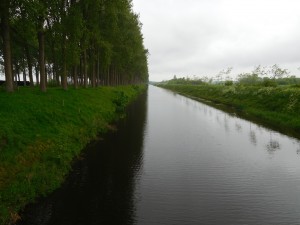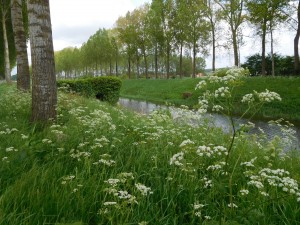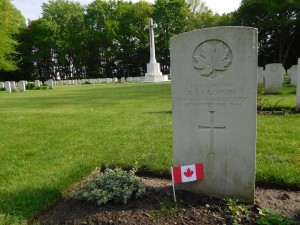Today we ventured to the Netherlands to explore some of the battles of the Scheldt. On our way we passed by a rather curious lighthouse in Sluis, which was the site of a naval battle. The town used to be a port but now lies about 10 km inland, leaving the lighthouse without ships to guide.
Before crossing to Walcheren Island we stopped at Hoofdplaat and startled some sheep before discussing 9 Brigade’s landing further up the beach for their campaign in the Breskins Pocket. Clearing the Pocket was part of the larger task of forcing the German Army out of the Scheldt Estuary so the allies could safely use the liberated port at Antwerp instead of transporting supplies from Normandy, which was becoming more and more difficult. While the landings and the battles that followed were successful, the men had been fighting since June and the regiments needed more people. The divisive issue of conscription reared it’s ugly head just in time for elections in Canada. As Canadians and Mackenzie King were deciding what to do (about 16,000 conscripts would arrive in Europe in early 1945), 9 Brigade carried on.
From Hoofdplaat we stopped at the memorial to the men from 9 Brigade who died liberating the area and then crossed under the Westerscheldt, through a six km tunnel, to Walcheren Island where the 2nd Canadian Division fought some hard-won battles throughout the fall of 1944. We disembarked at Westkapelle on the west side of the island to discuss the Dutch war experience. The residents of Westkapelle had largely been spared the harsh occupation that was commonplace on the mainland. Because of this experience, the local reaction to liberation in October 1944, was mixed at best. The majority of the island is below sea level and is protected by dykes. In early October, the allies breached the dykes and flooded the town. Though the Germans did surrender, most of the residents lost their homes and their livelihoods, and some even lost their lives. The sense that liberation and destruction can be interchangeable was captured in the exhibits at the museum in Westkapelle.
Before we pressed on to the Walcheren causeway where 2nd Division had fought, I took a moment during our brief break for lunch and wandered down to the edge of the North Sea. The tour moves at such a fast pace to fit in as many places as possible (I wouldn’t have it any other way), there isn’t always time to reflect on what we see and learn. There’s a point where all the cemeteries with the white headstones blend together and you forget that each of those markers represents at least one person who was killed. This was the first day we didn’t visit a cemetery. Instead of the peaceful (and sometimes eerie) quiet of the Commonwealth cemeteries, where the only sounds are birds singing, we were on a reclaimed island where, standing at the waters edge, the only sound was the waves crashing – both peaceful and violent at the same time. It brought back the reality of everything I had seen and experienced so far and the force of it weighed heavy on my heart.
We crossed the island to the Walcheren causeway, which was a narrow, flat strip of ground. The initial attacks were repelled by the Germans who were determined to hold their position. The battle was a costly distraction to prevent the Germans from reinforcing Westkapelle. The Canadians did take the causeway after four days of fighting and almost 80 casualties. By this time, Field Marshal Montgomery was finally recognizing the necessity of supporting the campaigns in the Scheldt. The sudden availability of resources would dramatically change the shape of the campaigns the Canadians would fight in the coming weeks.
Our last stop of the day, before heading back to Brugge, was the site of the Ijzendijke explosion. On 19 October, 1944, the tank crews from 284 Armoured Assault Squadron Royal Engineers received supplies from the 7th Canadian Infantry Brigade Company, Royal Canadian Army Service Corps. In addition to regular supplies, such as rations, ammunition, and petrol, they also brought nitroglycerin for the “Conger.” At 1300 hours on 20 October a huge explosion rocked the camp. About 40 British and Canadian soldiers were killed and at least 50 more were wounded. Ten armored vehicles were also destroyed. The squadron was out of action for almost a month following the explosion.
With these events in mind, we returned to Belgium to decompress and prepare for the battles that were still to come.
Katie Beaudette




